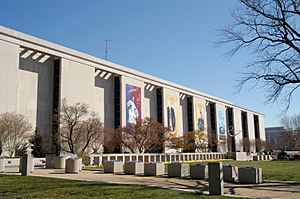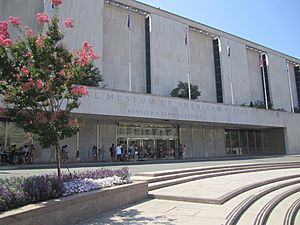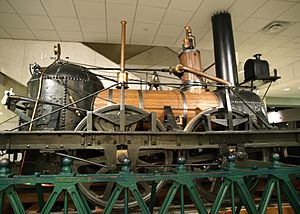National Museum of American History facts for kids
 |
|

Aerial view of the museum in 2010
|
|
| Established | 1964 |
|---|---|
| Location | 1300 Constitution Ave. NW, Washington, D.C., U.S. |
| Type | History museum |
| Visitors | 2.1 million (2023) |
| Architect | McKim, Mead & White |
| Public transit access | |
The National Museum of American History is a super cool museum in Washington, D.C.. It's like a giant treasure chest filled with amazing things from the past of the United States. You can see everything from old tools to famous flags, showing how America grew. One of its most special items is the original Star-Spangled Banner flag! This museum is part of the famous Smithsonian Institution. You can find it right on the National Mall.
Lots of people love visiting this museum! In 2023, over 2 million visitors explored its halls. This made it one of the most visited museums in the U.S.
Exploring American History
The National Museum of American History helps us understand the past. It shows how people lived, worked, and created new things. The museum collects and takes care of items that tell America's story. These items cover social life, politics, culture, science, and military history.
How the Museum Began
The museum first opened its doors in 1964. Back then, it was called the Museum of History and Technology. It was designed by a famous architecture company. In 1980, its name changed to the National Museum of American History. This new name better showed its goal: to share the story of the American people.
The land where the museum stands used to have temporary buildings. These were built in 1942 during a war.
Making the Museum Even Better
The museum closed for a big makeover from 2006 to 2008. This renovation cost about $85 million. During this time, many exciting changes happened:
- A new, tall atrium was added. It has a glass roof and displays cool artifacts.
- A grand staircase now connects the first and second floors.
- A new welcome area helps visitors start their adventure.
- Six special objects were placed to guide visitors around.
- New exhibit halls opened, like the Jerome and Dorothy Lemelson Hall of Invention.
- A special room was built to protect the original Star-Spangled Banner flag. This room keeps the flag safe from harm.
Another renovation started in 2012 for the west wing. This project cost $37 million. It added new exhibit spaces and an education center. New windows now offer amazing views of the National Mall. Interactive features were also added to the exhibits. The first part of this renovation opened in 2015. The rest of the west wing opened in 2016 and 2017.
What You Can See Inside
Each part of the museum's three exhibit floors has a special object. These objects help show the main idea of that area. Some of these cool items include:
- The John Bull locomotive, a very old train.
- A lunch counter from the Greensboro sit-ins, which tells an important story about civil rights.
- A unique draft wheel.
- The 1865 Vassar Telescope.
- A large George Washington Statue.
- A Red Cross ambulance.
- A car from Disneyland's Dumbo Flying Elephant ride.
Long walls of glass cases also line the first and second floors. These "artifact walls" show items grouped by themes. Themes include arts, popular culture, business, home life, and technology.
Exploring Each Floor
Lower Level Fun
The lower level has an exhibit called Taking America to Lunch. It shows the history of American lunch boxes, many with pop culture designs. You can also find the museum's food court, the Stars and Stripes Café, here. Ride simulators offer extra fun.
First Floor Adventures
The East Wing of the first floor (1 East) focuses on transportation and technology. Here you'll find America on the Move and Lighting a Revolution. The John Bull locomotive is a star attraction. Other items include old trains and a model of a Chicago "L" elevated train station.
The West Wing (1 West) is all about science and new ideas. Exhibits include Science in American Life and Bon Appétit! Julia Child's Kitchen. Spark!Lab is a hands-on area where you can invent things. The Vassar Telescope is the main object here.
You can also find a café and the main museum store on the first floor. The main entrance from Constitution Avenue is also on this floor.
Second Floor Discoveries
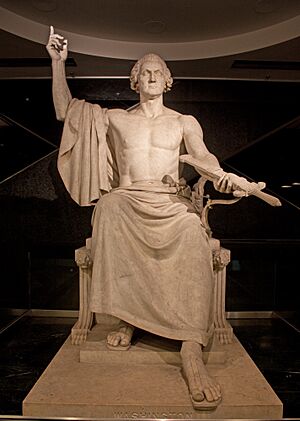
The East Wing of the second floor (2 East) explores American ideals. The Albert Small Documents Gallery shows different historical papers. For example, a copy of the Gettysburg Address was once displayed here. The Greensboro lunch counter is a key item in this section.
In the center of the second floor (2 Center) is the original Star Spangled Banner Flag. This famous flag inspired Francis Scott Key's poem, which became our national anthem. The flag is in a special climate-controlled room. Nearby, an interactive screen lets you explore a digital copy of the flag.
The large George Washington statue is the main object in the West Wing (2 West). This statue was made by Horatio Greenough. You can also see an entire old colonial house from Massachusetts here. It's part of the "Within These Walls" exhibit.
The second floor also has the museum's welcome center and another store. This floor leads out to Madison Drive and the National Mall.
Third Floor Journeys
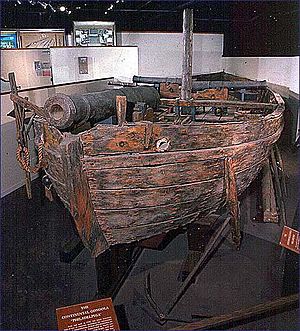
The East Wing of the third floor (3 East) focuses on U.S. military history. Exhibits include The Price of Freedom: Americans at War and the gunboat Philadelphia.
The center of the third floor (3 Center) has The American Presidency: A Glorious Burden. This exhibit looks at the lives of U.S. presidents. It also features the popular First Ladies of America exhibit. This display shows their contributions and changing roles, including their beautiful dresses.
The West Wing (3 West) is all about entertainment, sports, and music. You can find Thanks for the Memories: Music, Sports and Entertainment History here. There's also the Hall of Musical Instruments and The Dolls' House. A car from Disneyland's Dumbo the Flying Elephant ride is also on display. A newer exhibit, Entertainment Nation, features items from famous people like Judy Garland and Prince. It also has props from Star Wars and Sesame Street.
Outdoor Art and Sculptures
Outside the museum, you can find cool sculptures. In 1967, a tall abstract sculpture called Infinity was placed near the National Mall entrance. It was one of the first abstract sculptures in Washington D.C. It's a shiny stainless steel ribbon on a granite tower.
Another sculpture, Gwenfritz by Alexander Calder, is on the west side. This steel sculpture was first placed in 1969. It was moved for a while but returned to its original spot in 2014. It now sits in a pool of water, just as the artist imagined.
Museum Archives
The museum also has an Archives Center. This center collects and keeps important historical records. These records come in many forms, like old papers, photos, and recordings. They help researchers learn more about America's history.
The Archives Center has over 12,000 feet of shelving! It holds records about radio, TV, computers, and other technologies. It also has collections on advertising, music, and musical instruments.
Lemelson Center for Invention
The Jerome and Dorothy Lemelson Center for the Study of Invention and Innovation is a special part of the museum. It creates programs, books, and exhibits about invention. Its goal is to teach people about new ideas and encourage creativity in young people. The center wants everyone to see how important invention is to American history.
The center offers free learning materials for classrooms. It also organizes traveling exhibits, like Invention at Play. It helps the museum collect papers and materials from American inventors.
Past Exhibits to Remember
The museum has hosted many interesting exhibits over the years.
- Slavery at Jefferson's Monticello: Paradox of Liberty was a special exhibit in 2012. It was the first time a museum on the National Mall explored a president's connection to slavery.
- 24 Hours in Cyberspace opened in 1997. It celebrated a huge online event from 1996. The exhibit showed 70 photos from this project.
- Treasures of American History was a temporary display.
- A Nation of Nations celebrated the American immigrant experience. It showed how immigrants helped build the United States.
See also
 In Spanish: Museo Nacional de Historia Estadounidense para niños
In Spanish: Museo Nacional de Historia Estadounidense para niños
- Architecture of Washington, D.C.


